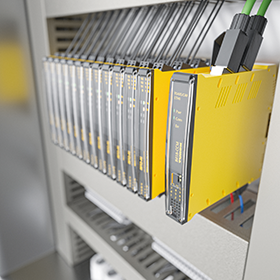

The housing of increasingly more powerful devices in ever smaller spaces is a sign of technological progress. For the control cabinet, the compact design of modern devices either means smaller outer dimensions or the possibility to house a greater number of electronic components. Innovation, however, also has its downside. In this case the build-up of heat. Extreme or irregular temperature conditions in the control cabinet can cause power loss, or even the failure of individual devices. Smart solutions for condition monitoring are therefore all the more important in addition to an effective device layout. The IM18-CCM, Turck Banner’s latest compact climate monitor and door guard, brings condition monitoring to the IT world.
Detecting anomalies before it’s too late
Risks of heat generation can be reduced when a control cabinet is being fitted with components. Arranging devices in moderately-sized blocks, preventing air flow barriers caused by unfavourably laid cables or cable ducts and installing heat sensitive components as close to the bottom of the cabinet as possible, allow designers to achieve good basic conditions. However, even with an optimum topology or ventilation with air conditioning systems, it makes sense to monitor the climatic conditions in the control cabinet. This enables maintenance technicians to see any anomalies early in order to avert malfunctions, especially when devices are housed in remotely located switch boxes. This applies also to outdoor areas where the weather is an external factor.
Three-in-one monitoring on the DIN rail
A few years ago, Turck Banner added cabinet guards IM12-CCM and IMX12-CCM (with Ex approval) to its portfolio as an easy-to-expand condition monitoring solution. The compact devices are mounted on the DIN rail and feature three on-board sensors for monitoring air temperature, humidity and the door gap. The IM(X)12 uses a configurable limit value function to then send a signal if values above or below the defined limit values occur. This would indicate that a device has overheated, condensation has formed in the control cabinet, or the door was not properly closed.
The IM12-CCM features an internal data logger with a time stamp and stores data for up to two years. This enables users to detect creeping changes over long time periods, and rectify the cause. An interface enables two cabinet guards to be operated in master-slave mode in order to monitor correct door closing and the other limit values at two points in the control cabinet. The master processes the data of the slave and sends a signal to the controller. The standard IM12-CCM comes with two switch contacts and an IO-Link interface. Quick teach mode enables the user to set the limit values in the field. Alternatively, parameters can be set via IO-Link or an FDT framework such as PACTware.
Connecting the factory level to the IT world
The IM18-CCM takes everything one step further by making it possible not only to display the condition of control cabinets locally, but to also transfer the data to the IT world. This slim 18 mm device sends the measured values of the sensors to higher-level systems via its Ethernet interface. Theoretically this can go as far as the cloud, thus giving maintenance personnel access to actual climatic data at any time, via mobile terminals. The boundary between the operative level and the IT infrastructure is thus gradually disappearing, which means users can analyse factory floor data from their offices.
More interfaces, more memory
Temperature, humidity and the security of control cabinets are variables that play an important role in any plant concept. With the right device layout and effective ventilation, designers can ensure the basis for the optimum availability of electronic components. Compact and easy to handle condition monitoring tools for providing information on critical measured values at any time are also available, in addition to cabinet guards.
Following on from the proven devices of the IM12 series, Turck’s IM18 -CCM builds the bridge to the IIoT and also provides the freedom for bespoke customer solutions. Anyone wishing for an even greater variety of interfaces will be able to make use of a second device version this year, which offers an additional Ethernet input as well as universal I/Os, a USB host and additional memory.
| Tel: | +27 11 453 2468 |
| Email: | [email protected] |
| www: | www.turckbanner.co.za |
| Articles: | More information and articles about Turck Banner Southern Africa |

© Technews Publishing (Pty) Ltd | All Rights Reserved